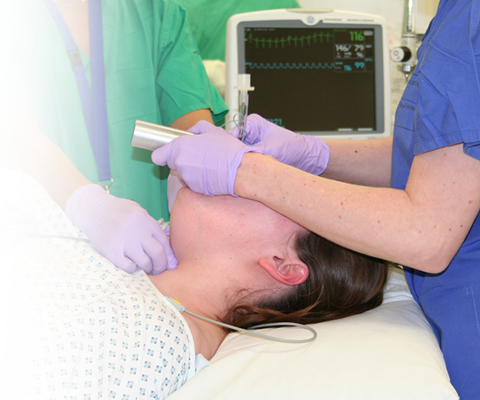Question:
What are the implications for anaesthesia of the upper GI changes in pregnancy?
Click here for the answer.

Question:
What are the implications for anaesthesia of the upper GI changes in pregnancy?
Answer:
Regurgitation and aspiration of hyperacid gastric contents is more likely than in non-pregnant women. If general anaesthesia is chosen, then rapid-sequence induction and cricoid pressure are considered mandatory by most anaesthetists for all obstetric patients.
Question:
Is a rapid-sequence induction considered mandatory for all pregnant women? If it isn’t, then what criteria are used to decide when it is necessary?
Click here for the answer.

Question:
What are the implications for anaesthesia of the upper GI changes in pregnancy?
Answer:
Regurgitation and aspiration of hyperacid gastric contents is more likely than in non-pregnant women. If general anaesthesia is chosen, then rapid-sequence induction and cricoid pressure are considered mandatory by most anaesthetists for all obstetric patients.
Question:
Is a rapid-sequence induction considered mandatory for all pregnant women? If it isn’t, then what criteria are used to decide when it is necessary?
Answer:
No. In selected women in the first trimester of pregnancy undergoing procedures such as suction termination of pregnancy, it is not considered mandatory. Note that many of the changes that increase the risks of aspiration are already present in the first trimester. It is wise to be cautious even in the first trimester.
It is customary to regard all women at or over 16-18 weeks pregnancy as having a full stomach. Prior to this gestation, in the absence of other risk factors, it is not mandatory to use a rapid-sequence induction technique.
Question:
How soon after delivery is it acceptable to induce general anaesthesia without using a rapid-sequence induction?
Click here for the answer.
Question:
What are the implications for anaesthesia of the upper GI changes in pregnancy?
Answer:
Regurgitation and aspiration of hyperacid gastric contents is more likely than in non-pregnant women. If general anaesthesia is chosen, then rapid-sequence induction and cricoid pressure are considered mandatory by most anaesthetists for all obstetric patients.
Question:
Is a rapid-sequence induction considered mandatory for all pregnant women? If it isn’t, then what criteria are used to decide when it is necessary?
Answer:
No. In selected women in the first trimester of pregnancy undergoing procedures such as suction termination of pregnancy, it is not considered mandatory. Note that many of the changes that increase the risks of aspiration are already present in the first trimester. It is wise to be cautious even in the first trimester.
It is customary to regard all women at or over 16-18 weeks pregnancy as having a full stomach. Prior to this gestation, in the absence of other risk factors, it is not mandatory to use a rapid-sequence induction technique.
Question:
How soon after delivery is it acceptable to induce general anaesthesia without using a rapid-sequence induction?
Answer: It is usual to recommend a RSI within 48 h of delivery. After this period, the risk returns to pre-pregnant levels.